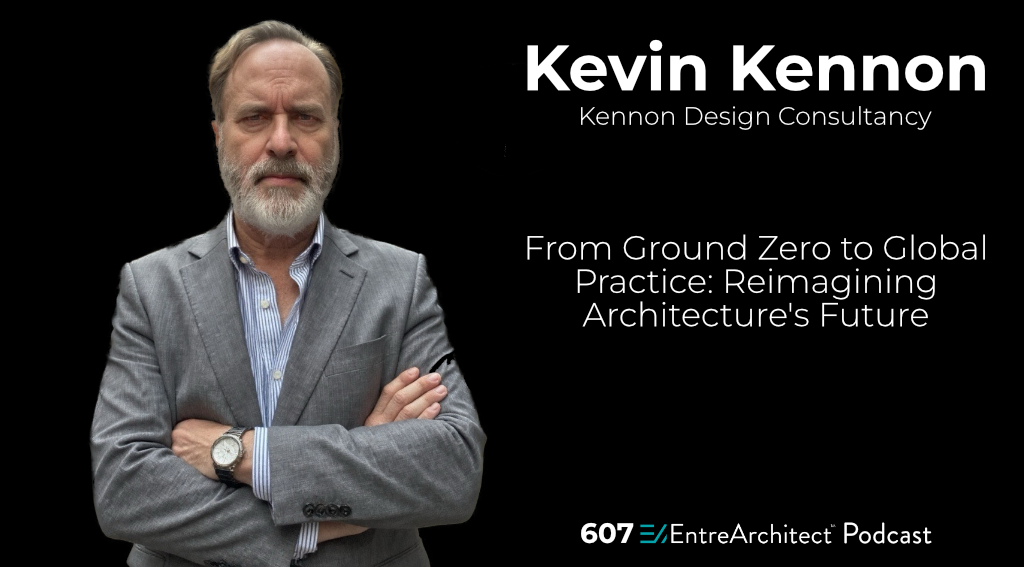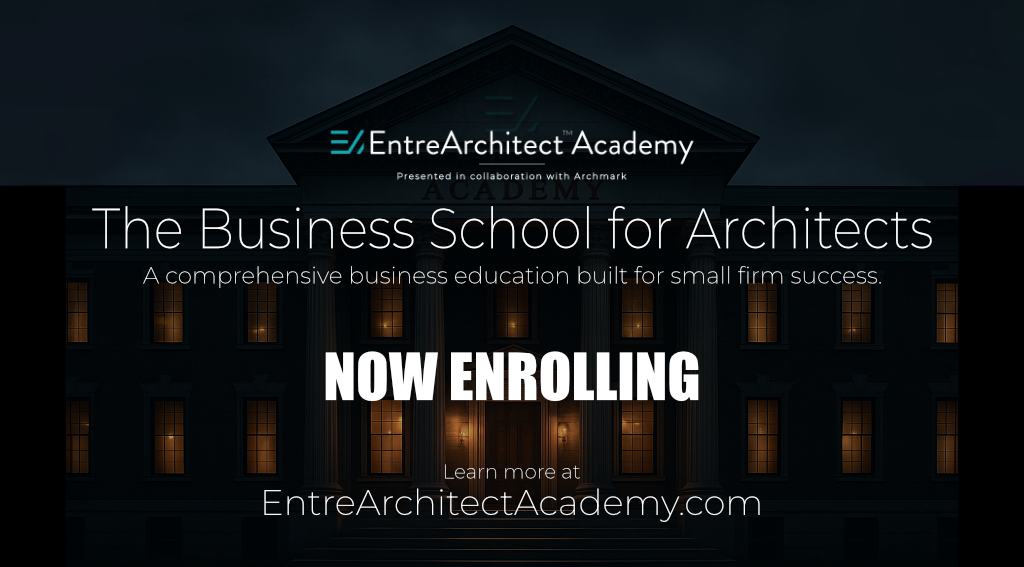
When I invited Kevin Kennon to the podcast, I knew we’d have a powerful conversation. Kevin’s resume alone—Barclays’ North American HQ, the Rodin Museum in Seoul, and over four decades of thought leadership at the intersection of design excellence and ecological responsibility—speaks volumes.
But it was his deeply personal story about Ground Zero that reframed the entire conversation around a central question: What is the true value of architecture?
Kevin’s answer isn’t just about buildings. It’s about people, place, healing, and vision. And it’s a message every small firm architect needs to hear right now.
Visit EntreArchitect.com/607 to listen to the full conversation.
Architecture That Heals
Kevin and I talked about how, just weeks after 9/11, he gathered friends and proposed a public viewing platform at Ground Zero. Amid the chaos and grief, this modest plywood structure—assembled from New York sidewalk scaffolding and elevated above St. Paul’s Chapel—provided a dignified space for reflection.
Thousands lined up for hours to see what remained of the towers, to grieve, and to begin to heal. As Kevin said, “Architecture met the moment.”
That’s the kind of value we’re talking about—not how much steel or glass went into a project, but how it serves people in their deepest moments of need. That experience changed Kevin’s life and launched his independent practice in 2002.
The Power of Collaboration
One of the through-lines in Kevin’s story is collaboration. Over and over again, he assembled teams of trusted colleagues—not just for the memorial platform, but for the design competition that followed, and in forming the nucleus of his new firm.
He doesn’t believe in the solitary genius model of architecture. He believes in people. “We don’t do this by ourselves,” he told me. And that truth has shaped every part of his multidisciplinary career.
If you’re building a small firm, that insight is gold. Whether it’s consultants, clients, or your own team—your power is in your relationships. And the better you collaborate, the greater the impact you can make.
Beyond Buildings: A Vision-Driven Career
Kevin doesn’t just run an architecture firm. He operates multiple ventures, including a nonprofit inherited from Peter Eisenman—the Institute for Architecture and Urban Studies—which he’s reimagining as a new digital publication highlighting emerging talent. He also consults as an expert witness, advises on construction conflicts, and develops wilderness hospitality projects.
Why so many ventures? Because Kevin views architecture not as a profession defined by narrow specialties, but as a broad creative practice with cultural impact.
“I’ve always advocated a multidisciplinary approach,” he said. “I don’t like being pinned down.” It’s this mindset that’s allowed him to move beyond traditional boundaries while staying rooted in his architectural core.
Redefining the Value of Architecture
Again and again, our conversation came back to the value of architecture—not in dollars, but in meaning.
Kevin believes we’re at an inflection point. Between the rise of AI, climate change, and the expanding influence of the internet, our profession is being redefined. And if architects don’t step up and tell our stories, someone else will do it for us—or worse, we’ll disappear from the conversation entirely.
“I think we have to stop complaining as a group and take ownership of the narrative,” Kevin told me. “If we don’t do it, I don’t know who else is going to.”
That struck a chord with me. So many of us in the EntreArchitect Community have voiced this same frustration: “The world doesn’t understand what architects do.” But Kevin flips the script. The problem isn’t the world. The problem is us—we’re not telling our stories.
Why Storytelling Matters More Than Ever
If you’re a trained architect, you’re a trained storyteller. Remember studio? You didn’t just design. You had to present your ideas—your vision—for critique. That was storytelling.
Kevin believes that same skill can and must be applied more broadly. “You can’t sell dystopia,” he says. “You have to advocate for a better future. That’s what architecture is about.”
Whether it’s through podcasting, video, writing, or face-to-face conversation, every architect today has the tools to tell their story. And in doing so, we reclaim our value—not just as designers of buildings, but as creators of culture.
Embracing New Models of Practice
Another powerful insight from Kevin was his approach to distributed practice. Overhead, he says, is the killer of small firms. Instead of following the old model, he’s using his network to outsource work to younger firms, partnering and collaborating across disciplines, and using AI tools to increase productivity.
“I’m a lousy employee,” he laughed, “but I’m good at setting the tone and establishing direction.”
That’s leadership. And that’s a model that small firm architects can learn from—especially those of us looking to expand without growing headcount or moving into massive office space.
We don’t need to do more with less. We need to do smarter with the right partners.
The Optimism of the Architect
Above all, Kevin reminded me that architects are, at heart, optimists. “How can you have the courage of your convictions,” he asked, “without believing the future can be better?”
And in that, we are the storytellers of utopia. Even if the road is long, we’re the ones who envision something better, who collaborate to make it real, and who leave a legacy that outlives us.
That’s the value of architecture.
And that’s why it’s never been more important to tell our stories.
To hear the full conversation with Kevin Kennon, including his advice for young architects, the evolution of his wilderness hospitality projects, and how he manages multiple businesses while staying grounded in vision and purpose, visit EntreArchitect.com/607.
What part of Kevin’s story resonated most with you?
Let me know inside the comments below.
Love. Learn. Share.

Leave a Reply